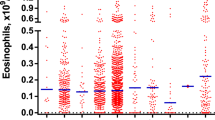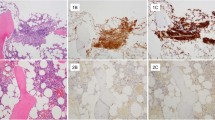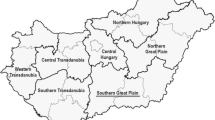Abstract
The composition of reactive cell populations, which constitute the majority of tumor load in Hodgkin’s lymphoma (HL), can influence the prognosis of the disease. Besides widely accepted and applied prognostic scores, the authors evaluate biological factors that may have a prognostic impact. Previous data indicate that the rate of eosinophils and mast cells in the reactive cell population, determined already at diagnosis, can be used for this purpose. Histological samples from 104 patients with HL with an average follow-up period of 110 (24–214) months were retrospectively analyzed. Mast cell positivity was associated with better overall survival, although this difference was only of borderline statistical significance (p=0.092). No significant difference was found in parameters like overall survival (OS, p=0.906) or event-free survival (EFS, p=0.307) of eosinophil-positive vs. -negative cases or in EFS (p=0.742) of mast cell-positive vs. -negative individuals (criterion for a positive specimen was more than 5% of appropriate cells in the reactive cell population). Looking at the effect of eosinophilia and mastocytosis together, there was no significant difference between the subgroups categorized according to the combined presence of the two cell types. It seems that tissue eosinophil and mast cell predominance have no prognostic value that could be used in clinical practice, although a tendency for correlation of mast cell positivity with overall survival could be seen. For a definitive statement, multicenter studies should be performed involving a higher number of patients suffering from HL.
Similar content being viewed by others
References
Axdorph U, Porwit-MacDonald A, Grimfors G, et al: Tissue eosinophilia in relation to immunopathological and clinical characteristics in Hodgkin’s disease. Leuk Lymphoma 42: 1055–1065, 2001
Costello R, O’ Callaghan T, Sebahoun G: Eosinophils and antitumour response. Rev Med Interne 6: 479–484, 2005
d’Amore ES, Lee CK, Aeppli DM, et al: Lack of prognostic value of histopathologic parameters in Hodgkin’s disease, nodular sclerosis type. A study of 123 patients with limited stage disease who had undergone laparotomy and were treated with radiation therapy. Arch Pathol Lab Med 116: 856–861, 1992
Enblad G, Sundstrom C, Glimelius B: Infiltration of eosinophils in Hodgkin’s disease involved lymph nodes predicts prognosis. Hematol Oncol 11: 187–193, 1993
Fischer M, Juremalm M, Olsson N, et al: Expression of CCL5/RANTES by Hodgkin and Reed-Sternberg cells and its possible role in the recruitment of mast cells into lymphomatous tissue. Int J Cancer 107: 197–201, 2003
Glimelius I, Edstrom A, Fischer M, et al: Angiogenesis and mast cells in Hodgkin lymphoma. Leukemia 12: 2360–2362, 2005
Hanamoto H, Nakayama T, Miyazato H, et al: Expression of CCL28 by Reed-Sternberg cells defines a major subtype of classical Hodgkin’s disease with frequent infiltration of eosinophils and/or plasma cells. Am J Pathol 164: 997–1006, 2004
Hasenclever D, Diehl V: A prognostic score for advanced Hodgkin’s disease. N Engl J Med 339: 1506–1514, 1998
Hedvat CV, Jaffe ES, Qin J, et al: Macrophage-derived chemokine expression in classical Hodgkin’s lymphoma: application of tissue microarrays. Mod Pathol 12: 1270–1276, 2001
Henry-Amar M, Friedman S, Hayat M, et al: Erythrocyte sedimentation rate predicts early relapse and survival in early-stage Hodgkin’s disease. The EORTC Lymphoma Cooperative Group. Ann Intern Med 114: 361–365, 1991
Jundt F, Anagnostopoulos I, Bommert K, et al: Hodgkin/ReedSternberg cells induce fibroblasts to secrete eotaxin, a potent chemoattractant for T cells and eosinophils. Blood 94: 2065–2071, 1999
Kadin M, Butmarc J, Elovic A, et al: Eosinophils are the major source of transforming growth factor-beta 1 in nodular sclerosing Hodgkin’s disease. Am J Pathol 142: 11–16, 1993
Molin D: Bystander cells and prognosis in Hodgkin lymphoma. Review based on a doctoral thesis. Ups J Med Sci 109: 179–228, 2004
Molin D, Edstrom A, Glimelius I, et al: Mast cell infiltration correlates with poor prognosis in Hodgkin’s lymphoma. Br J Haematol 119: 122–124, 2002
Molin D, Fischer M, Xiang Z, et al: Mast cells express functional CD30 ligand and are the predominant CD30L-positive cells in Hodgkin’s disease. Br J Haematol 114: 616–623, 2001
Mosialos G, Birkenbach M, Yalamanchili R, et al: The EpsteinBarr virus transforming protein LMP1 engages signaling proteins for the tumor necrosis factor receptor family. Cell 80: 389–399, 1995
Pinto A, Aldinucci D, Gloghini A, et al: Human eosinophils express functional CD30 ligand and stimulate proliferation of a Hodgkin’s disease cell line. Blood 88: 3299–3305, 1996
Pinto A, Aldinucci D, Gloghini A, et al: The role of eosinophils in the pathobiology of Hodgkin’s disease. Ann Oncol 8(Suppl 2): 89–96, 1997
Ribatti D, Nico B, Vacca A, et al: Do mast cells help to induce angiogenesis in B-cell non-Hodgkin’s lymphomas? Br J Cancer 77: 1900–1906, 1998
Samoszuk M, Kanakubo E, Chan JK: Degranulating mast cells in fibrotic regions of human tumors and evidence that mast cell heparin interferes with the growth of tumor cells through a mechanism involving fibroblasts. BMC Cancer 5: 121, 2005
Samoszuk M, Ramzi E: IgE, Reed-Sternberg cells, and eosinophilia in Hodgkin’s disease. Leuk Lymphoma 9, 315–319, 1993
Skinnider BF, Mak TW: The role of cytokines in classical Hodgkin lymphoma. Blood 99: 4283–4297, 2002
Sorbo J, Jakobsson A, Norrby K: Mast-cell histamine is angiogenic through receptors for histamine 1 and histamine 2. Int J Exp Pathol 75: 43–50, 1994
Teruya-Feldstein J, Jaffe ES, Burd PR, et al: Differential chemokine expression in tissues involved by Hodgkin’s disease: direct correlation of eotaxin expression and tissue eosinophilia. Blood 93: 2463–2470, 1999
Toth J, Dworak O, Sugar J: Eosinophil predominance in Hodgkin’s disease. Z Krebsforsch Klin Onkol Cancer Res Clin Oncol 89: 107–111, 1977
von Wasielewski R, Seth S, Franklin J, et al: Tissue eosinophilia correlates strongly with poor prognosis in nodular sclerosing Hodgkin’s disease, allowing for known prognostic factors. Blood 95: 1207–1213, 2000
Author information
Authors and Affiliations
Corresponding author
Rights and permissions
About this article
Cite this article
Keresztes, K., Szollosi, Z., Simon, Z. et al. Retrospective analysis of the prognostic role of tissue eosinophil and mast cells in Hodgkin’s lymphoma. Pathol. Oncol. Res. 13, 237–242 (2007). https://doi.org/10.1007/BF02893504
Received:
Accepted:
Issue Date:
DOI: https://doi.org/10.1007/BF02893504




